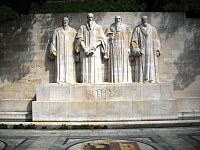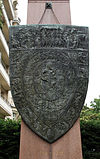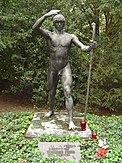Paul landowski
Paul-Maximilien Landowski (June 1, 1875 - March 31, 1961) was a French sculptor of Polish origin. Director of the Academy of Rome from 1933 to 1937. Member of the French Academy of Fine Arts in the Sculpture section from 1926 to 1961.
Biography
He is the grandson, on his mother's side, of the famous violinist and composer Henri Vieuxtemps. He was first married to Geneviève Nénot (1897-1911), daughter of Henri Paul Nénot, and had two children, the painter Nadine Landowski-Chabannes (1908-1943) and Max Jean Landowski (1911-1943), who died during the World War 2. An inconsolable widower, he married Amélie Cruppi, daughter of the politician Jean Cruppi. He is also the father of Marcel Landowski (1915-1999) and the pianist and painter Francoise Landowski-Caillet (1917-2007).
After secondary school at the Lycée Rollin (French: lycée Jacques Decour), he devoted himself to dramatic versification. During 1898, in the preparatory classes for the great schools (from French: hypokhâgne ), he discovered through Henri Barbusse the humanist philosophy, which marked all his work. The following year, he followed, parallel to his studies, the courses of the portrait painter Jules Lefebvre at the Académie Julian. He became an expert in anatomy by habitually following the dissections of the Paris School of Medicine (French: Faculté de médecine ) and drawing Professor Faraboeuf's teaching plates. He shows great passion for boxing.
He was admitted in 1895 to study Fine Arts. A student of Louis-Ernest Barrias, he won the Prix de Rome in 1900 with David combatiente. He remained at the French Academy in Rome until 1906. After returning from his stay at the Villa Medici he settled down by architects, artists and patrons on rue Moisson-Desroches (now rue Max Blondet) in Boulogne Billancourt. All that remains of his study is a small museum built after his death in a corner of the garden.
He received the Croix de Guerre in the Somme during the First World War. After the war he created more than 80 monuments to the deceased, including Les Fantômes. He was the creator of the images of the humanist hero, he became a the pseudo-official sculptor of post-war pacifist France and received commissions for major monuments in Paris (the statue of Saint Genevieve on the Pont de la Tournelle, the fountains at the Porte de Saint Cloud, the tomb of Marshal Foch) and abroad (Cristo del Corcobado)
In 1928 he participated in the art competitions of the Amsterdam Olympic Games, obtaining the gold medal in the sculpture competition for the statue entitled The Boxer- Le Boxeur.
He was director of the French Academy in Rome from 1933 to 1937. In 1939, he was appointed director of the School of Fine Arts in Paris, where he worked to implement a reform based on his conception of art teaching as a meeting of architecture, sculpture and painting.
In November 1941, together with Paul Belmondo and André Derain, he made the famous «trip to Berlin» (what would be called in France Groupe Collaboration), visiting all of Weimar Germany, like many other French artists in response to the Otto Abetz's invitation to collaborate intellectually in Goebbels's project to bring about a new Europe. As director of the ENSB-A and as a former close friend of Otto Abetz, when he was not yet a defender of Nazism, Landowski mediated in the release of his students imprisoned in Germany during the debacle. In the course of the purification process (in French, fr:épuration from which he emerged unscathed, he explained that he acted in his capacity to help rescue French prisoners, donating his fees to the prisoners' funds and in the hope of the release of the young artists, he adds that - although not all - he regrets his actions, thus acknowledging having been deceived.
On his death, he left behind two literary works, the first published while he was still alive: "Peut-on enseigner les Beaux-Arts?" (Is it possible to teach Fine Arts?), and the other, partly posthumous, his Diary, a fascinating personal testimony about the profession of sculptor from the First World War to the end of his life.
Paul Landowski was a Commander of the Legion of Honor.
Works
- David fighting (David combattant) - 1900(French title, David se prépare à lancer la fronde). With which he won the prize of Rome in 1900. The 31 cm high plaster sketch is located in the Boulogne-Billancourt Museum. Modeled in large format plaster:(163x81x130 cm) in the same museum. Different pieces cast in bronze to the lost wax distributed by different cities: n.o 1 Buenos Aires, n.o 2 Canada, n.o 3 Sydney (?), also at the Art Gallery of New South Wales, donation of G. Charpentier in 1961. Numbered specimens 163 cm high.
- Bronze reductions: 25 specimens numbered between 1907 and 1914; 110 cm Bronze (most natural in the musée-jardin of Boulogne-Billancourt; signed on the right side of the right foot [P. Landowski].
- Sculpture in the Paris Pantheon (1902) dedicated to the memory of the artists whose name has been lost, (À la mémoire des artistes dont le nom s'est perdu).
- The children of Cain (Les fils de Caïn) - 1906
- Bronze, garden of the Tuileries in Paris, terrace along the Seine. Representation: 3 men march elbow to elbow, the middle one carries a cranium of herbivores (probably a buffalo).
| |
The International Monument of Reform, generally known with the name Wall of Reformersis located in Geneva, Switzerland. Elevated in the current Bastiones Park and with a length close to the hundred meters, it is attached to a part of the old walls built in the centuryXVI and that surrounded the city until the middle of the centuryXIX. The monument was opened in 1909. The stone statues were made by the French sculptors: Paul Landowski and Henri Bouchard. The central group that appears in the image represents William Farel, Juan Calvino, Theodore Beza, and John Knox. 46°12′01′N 6°08′44′′E / 46.20028, 6.14556 |
- Monument to the glory of the French army, 1914–1918
- Located in Paris (XVI), the Plaza del Trocadero and the 11th of November. (Image on Flickr.com)
| |
48°0′28′′N 0°11′55′′E / 48.00778, 0.19861 |
| |
|
| |
The Piratini Palace is the current headquarters of the executive branch in the city of Porto Alegre, Brazil. It was built at the end of the centuryXIX. Paul Landowski made the two sculptures that keep the palace's front door. They represent the allegorical figures of Agriculture and Industry. 30°02′01′S 51°13′51′′ / -30.03361, -51.23083 |
| |
Soldier standing, central figure of the monument to the dead of Ault in the region of Somme France. This monument to the dead was made by Landowski in 1921. Its inauguration took place on October 16, 1921. The monument is attached to the wall of the church of Ault. |
- Monument to the dead of the normal École supérieure, 1923
| |
Red granite monolith over which a bronze shield is superimposed from a model of Landowski. In memory of the deceased during the 1st World War of the 16th District of Paris, based on an initiative by Lt Colonnel Weissweiller, founder president of the association. 48°51′50′N 2°16′34′′E / 48.86389, 2.27611 |
| |
Stone statuette located in Paris (V) on the Tournelle Bridge that saves the Seine. It has been registered with UNESCO World Heritage since 1991. 48°51′0′N 2°21′19′′E / 48.85000, 2.35528 |
- The fountains of the Saint-Cloud Gate - 1928-1932
- Las Fontaines de la Porte de Saint-Cloud, en la Plaza Port de Saint-Cloud, del XVI Distrito de Paris inauguradas en (1936). Paul Landowski, sculptor, and Robert Pommier and Jacques Billard, architects. The monumental sources were made to cover a large square created in 1926 for a tram and the train station and meeting point of seven ways, where the old doors and fortifications of the city had been. The fountains are characterized by its structure in two central cylindrical columns of fifteen meters high, with water jets and covered with bas-reliefs and night lighting, designed to serve as a symbolic entrance to the city. His creator, the sculptor Paul Landowski, wrote, "These are the first sources in Paris in which from the beginning the effects of light, architecture and sculpture were joined."
- Le Pavoismonument to the deceased in Algiers - 1929
| |
Outside Bronze installed on the Plaza del General de Gaulle in Montreuil-sur-Mer. The Field Marshal Douglas HaigFirst Earl Haig (*19 June 1861 - 28 June 1928) was a prominent British Empire military officer during World War I. In this conflict he led the British Expeditionary Force that fought in the Battle of Somme (1916) and the taking of Passchendaele (1917). 50°27′40.612′N 145′39.481′′E / 50.46128111, 1.76096694 |
| |
His most outstanding work was the Redeemer Christ or Christ of Corcovado, monumental statue of granite of 38 meters high (30 meters of figure plus 8 of peana), located on the top of the Corcovado mountain in Rio de Janeiro, Brazil, reaching 738 meters above sea level. Made in collaboration with the Brazilian engineer Heitor da Silva Costa This work was carried out in France given the impossibility of doing it in Brazil, later, the pieces were assembled in Rio and transported by rail to the top of the Corcovado. Where it remains since 1926 as the most emblematic symbol of Rio de Janeiro.
22°57′6′′S 43°12′39′ / -22.95167, -43.21083 |
- Bust of Doctor Armaingaud erected in Arcachon, where his center was against tuberculosis - 1933
- The Ghosts (Les Fantômes) - 1919-1935 --49°12′51′′N 3°24′36′′E / 49.21417, 3.41000
- Stone group consisting of 7 soldiers, heights of 8 meters, each incarnates a weapon and is erected on the hill of Chalmont in Oulchy-le-Château in Aisne, in the precise place where the fate of the Second Battle of the Marne was decided.
- This monument, property of the state is classified as a historical monument by an order of July 31, 1934.
| |
48°51′19′N 2°19′54′′E / 48.85528, 2.33167 |
- Monument to the fallen in Casablanca, Morocco
| |
|
- Efigie, The departure of the deceased relief on the sarcophagus, The Forge relief on the eardrum, Pity, Bond, Brotherly Love reliefs decorating the niche
- Visible sculptures on the tomb of the Darracq family in the Père-Lachaise cemetery.
- Monument to the dead of the superior normal school of the Ulm rue in Paris, figure of a wounded male nude blanding a torch (the arm has been countless times broken and replaced)
| |
Monumental Tomb of the French Field Marshal, Commander-in-Chief of the Allied Armies during the First World War, Ferdinand Foch. It is located in The Invalids of Paris. 48°51′18′N 2°18′45′E / 48.85500, 2.31250 |
| |
It is located in the Nordfriedhof cemetery in the city of Düsseldorf, Germany. It is made in metal and represents a male figure moving forward with one hand holding a staff and the other on the head. 51°15′28′′N 06°46′18′E / 51.25778, 6.77167 |
College
Collège Paul-Landowski, located at 94 rue Escudier in Boulogne-Billancourt. Architect: G. Merlet, 1981.
Museums
- Museum-garden Paul-Landowski, located in the number 14, rue Max-Blondat of Boulogne-Billancourt, on the site that occupied the sculptor's workshop, where he worked until his death in 1961.
- Le Centre Culturel Paul-Landowski, located in the avenue Morizet de Boulogne-Billancourt, which includes the Musée des Années Trente.
Contenido relacionado
Georgian alphabet
Azure
May 4th







